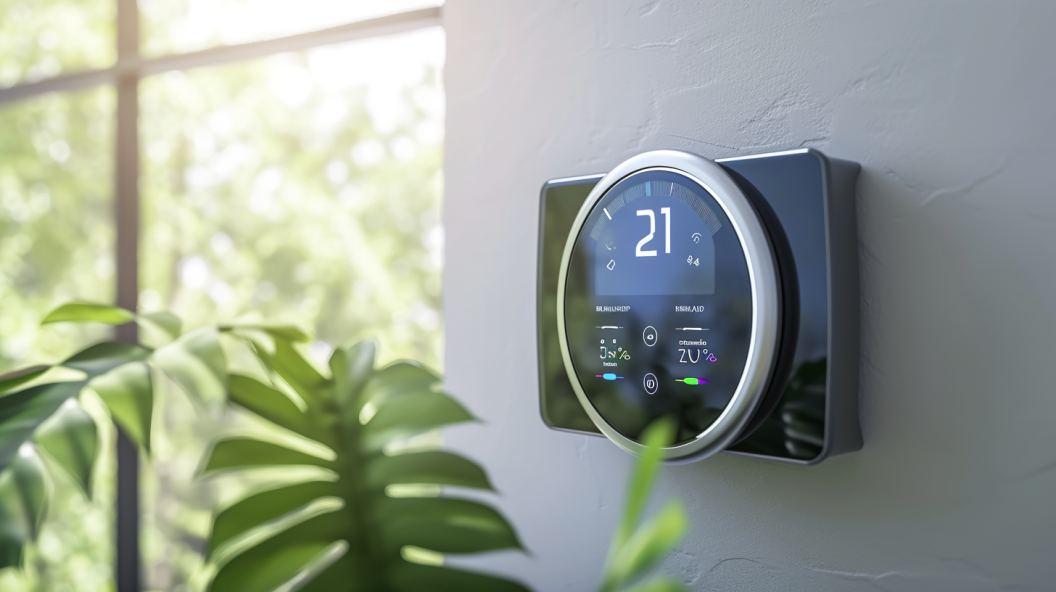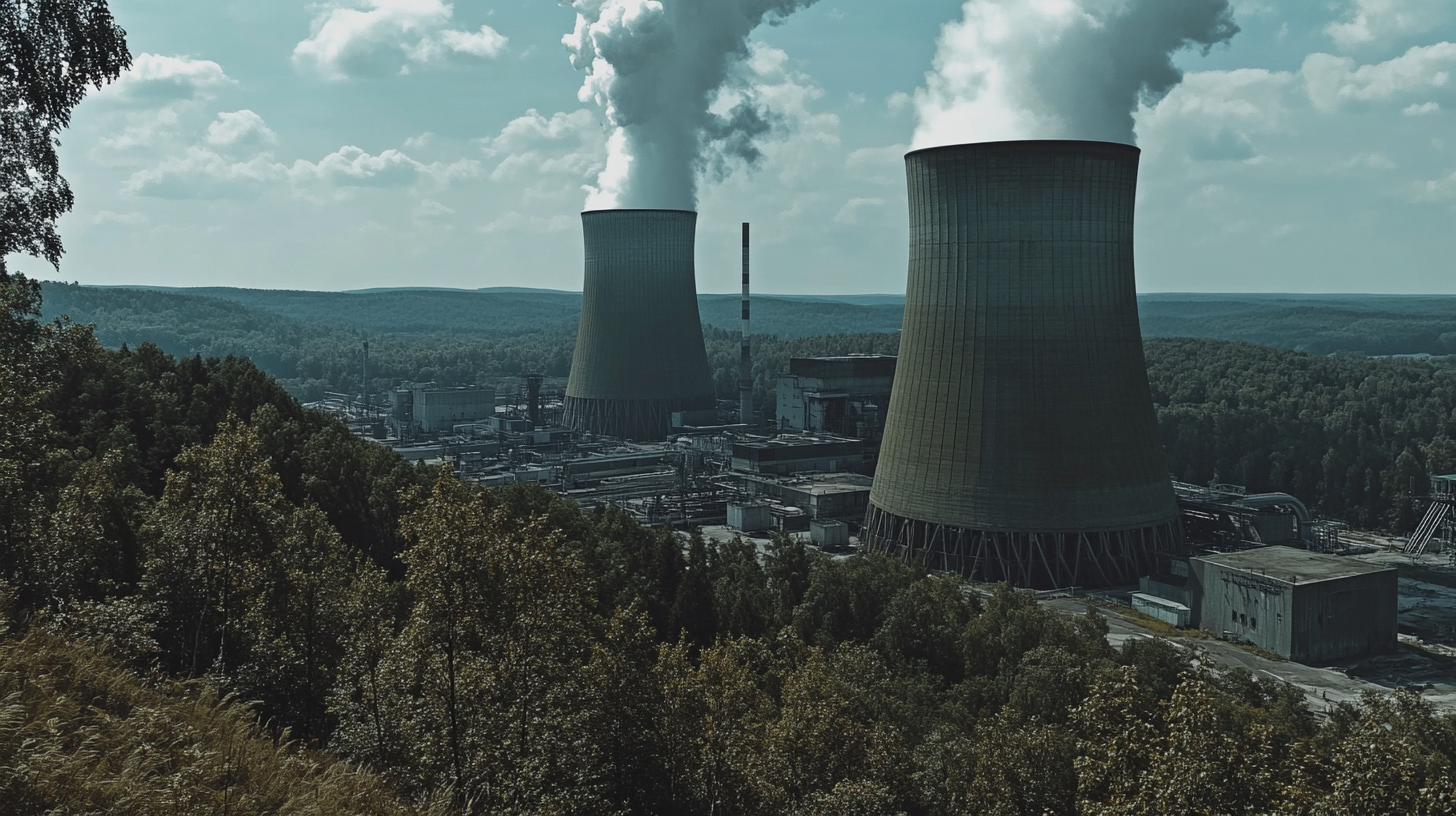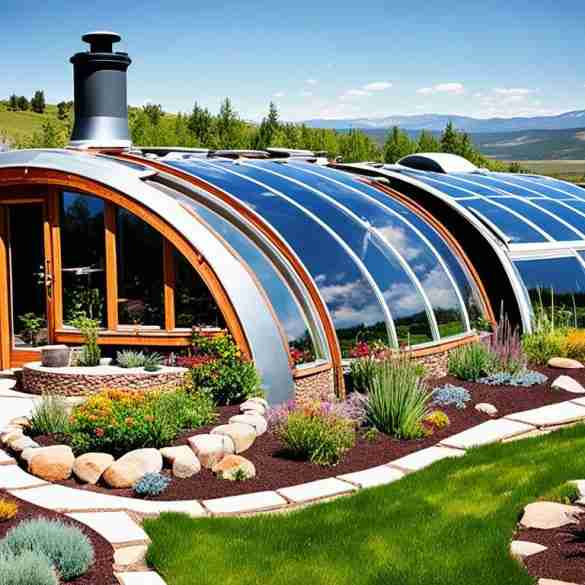Welcome to Sustainable Home Magazine, where exploring innovative and responsible ways to maintain comfort in your home aligns with our commitment to the planet. You might not realize it, but the heating and cooling solutions you choose have a profound impact on both your carbon footprint and energy bills. In our ongoing coverage of energy-efficient HVAC systems, we’d like to introduce you to a range of sustainable heating and cooling systems that not only promise reduced greenhouse gas emissions but also significant savings on energy costs.
The push towards green heating and cooling technologies isn’t just a trend—it’s a necessary shift as we face the increasing impacts of climate change. From universities like Santa Clara University to businesses and homeowners, the widespread adoption of renewable energy HVAC solutions illustrates a growing recognition of the significance of environment-friendly HVAC systems. By rethinking how we regulate temperature in our buildings, we can make strides in living more sustainably.
Key Takeaways
- The impact of HVAC systems on the environment and energy consumption is more significant than many realize.
- Adopting sustainable HVAC solutions not only benefits the environment but also has the potential to offer substantial financial savings.
- Renewable energy HVAC solutions are becoming more accessible and popular amongst a diverse range of entities, from educational institutions to private homeowners.
- Through technological advancements, green heating and cooling technologies are seeing increased efficiency and effectiveness.
- Implementing energy-efficient HVAC systems contributes to a significant reduction in CO2 emissions, playing a crucial role in fighting climate change.
Understanding Sustainable Heating and Cooling Systems
As readers of Sustainable Home Magazine, you are most likely seeking to reduce your carbon footprint and align your home with eco-friendly heating and cooling practices. It’s important to comprehend the two main approaches to sustainable HVAC solutions: passive and active systems. The selection between these can significantly affect not only environmental impact but also your wallet in the long run.
Passive systems focus on the clever use of a building’s design to naturally regulate temperature without mechanical intervention. Key features like light-colored roofing materials reflect rather than absorb heat, reducing the need for air conditioning. Similarly, windows can be strategically placed and treated with reflective coatings to maximize natural light while minimizing solar heat gain.
- Optimization of natural light
- Improved insulation techniques
- Heat-reflective exterior surfaces
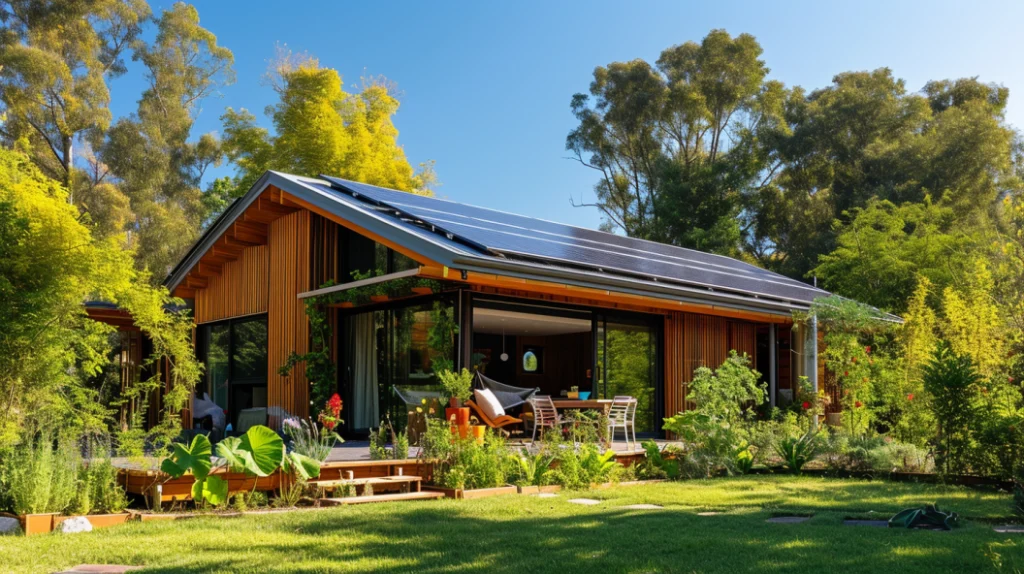
In contrast, active systems integrate the latest in renewable technology, using mechanical elements to harness resources such as solar and geothermal energy. Solar panels and geothermal heat pumps exemplify how we can tap into earth’s endless natural power to heat and cool our homes effectively.
- Solar thermal collectors
- Geothermal heat pump systems
- Photovoltaic units for electricity generation
Financially, both passive and active eco-conscious heating and cooling systems are becoming more accessible through governmental incentive programs. These incentives aim to reduce the upfront costs which can be a barrier to the adoption of sustainable technologies.
“Transitioning to a sustainable HVAC system not only supports the environment but also brings economic benefits in the form of reduced utility bills and tax incentives.”
By embracing these eco-friendly options, you take a substantial step towards a cleaner, more sustainable future. Whether you’re building a new home or retrofitting an existing one, these heating and cooling strategies are viable paths to a lower ecological footprint and increased energy independence.
The Growing Importance of sustainable heating and cooling systems
As you witness the changes in climate conditions, with extreme weather becoming the new norm, your reliance on Heating, Ventilation, and Air Conditioning (HVAC) systems surges, inadvertently contributing to the very issue you’re hoping to mitigate. There’s an undeniable urgency to redefine traditional HVAC systems, long known for their substantial energy consumption, and turn towards more climate-friendly HVAC technologies that not only promise energy-saving heating and cooling solutions but also ensure a healthier environment.
The quest for eco-friendly heating and cooling solutions is more than a matter of environmental preservation; it’s an initiative to alleviate the strain on our electrical grids—a concern highlighted by the recent power outages in states like California and Texas. The escalating demand for greener options reflects a societal acknowledgment of both the immediacy and the gravity of climate-related challenges.
Understanding the available alternatives to your traditional HVAC system can empower you to take meaningful action. For instance, consider the following options renowned for their energy efficiency:
- Solar-powered heating and cooling
- Geothermal heat pumps
- Hybrid systems utilizing smart technology
Transforming your home into an eco-friendly sanctuary doesn’t merely stem from a desire to reduce carbon footprints or adhere to environmental standards. It’s equally about proactive participation in a growing culture of sustainability, where energy efficiency becomes synonymous with modern living. Through the installation of climate-friendly HVAC technologies, you’re not just conserving energy; you’re also setting a new standard for living spaces now and into the future.
| Technology | Energy Savings | Environmental Impact | Longevity |
|---|---|---|---|
| Solar HVAC | Up to 50-70% | Reduces carbon emissions significantly | 20-25 years |
| Geothermal Pumps | 30-60% | Minimal ground disturbance | 25+ years for indoor, 50+ for ground loop |
| Hybrid Systems | Varies based on settings | Lower carbon emissions with efficient resource use | Depends on system design |
Remember, the switch to sustainable solutions extends beyond environmental benefits. It can lead to substantial financial gains over the system’s lifespan due to the remarkable drop in utility costs.
As part of Sustainable Home Magazine’s commitment to a greener future, we urge you to consider these alternatives for your heating and cooling needs. Embrace the transition to energy-saving heating and cooling solutions and become a pivotal part of the movement striving for a more sustainable and resilient society.
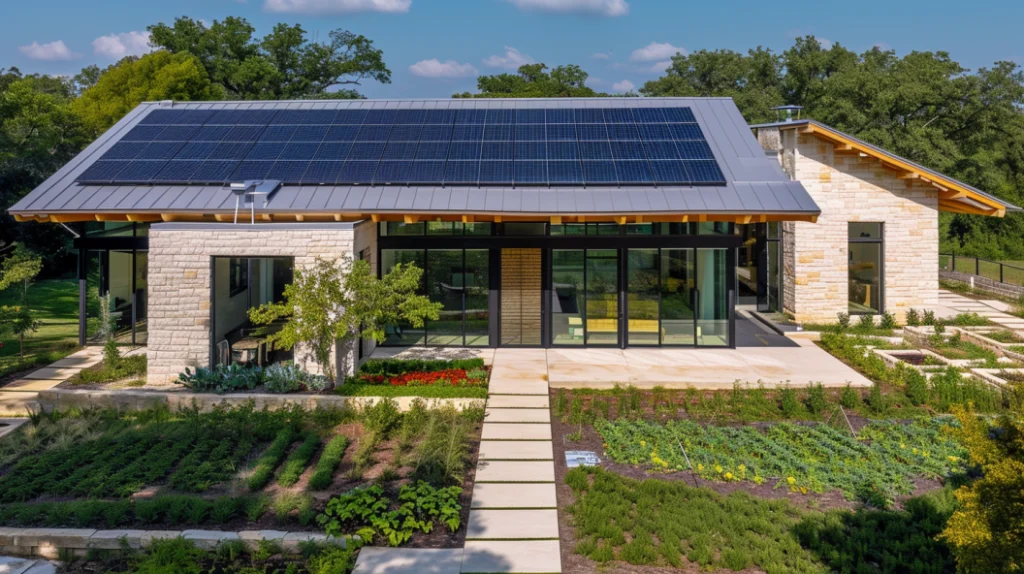
Harnessing Earth’s Temperatures: Geothermal Solutions
As you explore the options for sustainable heating and cooling, geothermal solutions stand out as a gateway to unprecedented energy efficiency. By embracing the stable warmth of the earth’s subsurface, geothermal systems deliver both heating and cooling with minimal environmental impact, allowing you to enjoy the comforts of your home while preserving the planet.
The Basics of Geothermal Heat Pumps
At the core of geothermal technology are the heat pumps that leverage the near-constant underground temperatures, which range from 42 to 80 degrees Fahrenheit. These innovative energy-efficient HVAC systems work by circulating a refrigerant or water solution through underground pipes, absorbing or dissipating heat depending on your heating or cooling needs. This process can achieve efficiencies upwards of 400%, significantly trimming your energy expenses.
Costs vs. Long-Term Savings in Geothermal Installations
Initially, the cost of installing a geothermal system may appear daunting, typically between $10,000 and $30,000. However, when you consider the long-term benefits, these renewable energy HVAC solutions are financially savvy investments. Not only do geothermal heat pumps reduce monthly utility bills, but they also have a lengthy lifespan, often exceeding 25 years for the indoor components and over 50 years for the ground loop.
The U.S. Department of Energy reports that geothermal heat pumps can save 30-60% on heating and 20-50% on cooling costs compared to conventional systems.
Regulatory Incentives for Geothermal Systems
Understanding the financial commitment that geothermal solutions require, governments provide incentives to ease the initial burden. The Renewable Energy Tax Credit, for instance, can offer significant savings. Depending on your location, state incentives and utility rebates may also be available, underscoring the push towards adopting these geothermal solutions as a cornerstone of modern, energy-efficient housing. By researching the incentives available to you, the upfront costs become a valuable investment into a sustainable future.
Solar Heating and Cooling: Tapping into the Ultimate Renewable Resource
As a reader of Sustainable Home Magazine, you’re likely seeking efficient ways to harness natural energy for a greener lifestyle. Solar energy, an inexhaustible source available virtually everywhere, offers innovative and environmentally sound methods to heat and cool your home. Understanding the fundamentals of Passive Solar Design Principles and Active Solar Energy Systems is pivotal in optimizing your home’s climatic comfort and energy use.
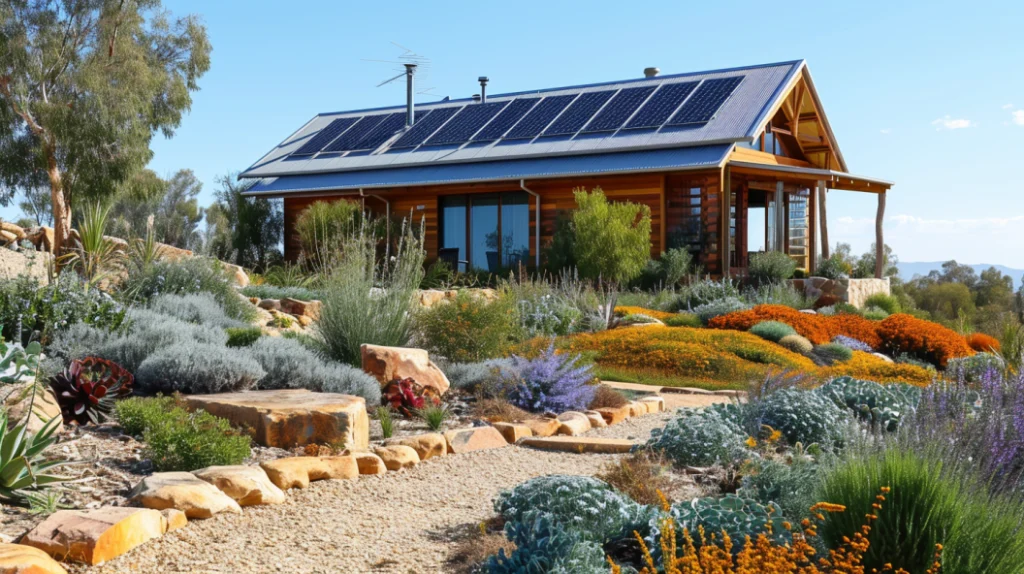
Passive Solar Design Principles
Passive Solar Design utilizes the innate qualities of your home’s materials to collect, store, and distribute the sun’s energy. By placing windows strategically and selecting materials with thermal mass, like concrete or brick, your home can absorb solar heat during the day and release it slowly at night, reducing the need for conventional solar heating and cooling methods. Moreover, overhangs and shading devices control the amount of solar gain, preventing overheating and harnessing natural light.
Active Solar Energy Systems
In contrast to passive design, Active Solar Energy Systems involve mechanical components to convert sunlight into usable heat, offering greater control and efficiency. These systems employ solar collectors, storage tanks, and a circulation system to provide heat and hot water. Whether you’re considering fluid-filled radiators or a forced air system, active solar technology seamlessly integrates with existing HVAC systems to regulate your home’s temperature. Despite the initial investment, solar incentives and rebates significantly lower the financial barrier to adopting these solar heating and cooling workhorses.
Turning to Biomass for Sustainable Warmth
Biomass heating systems are spearheading the move towards more eco-friendly heating and cooling options in residences and institutions alike. This shift represents a growing awareness and demand for sustainable energy practices. In this section of Sustainable Home Magazine, we’ll explore how systems powered by organic materials, such as wood chips and plant residues, offer a viable alternative to traditional fossil fuels. Not only do these systems provide a renewable source of energy, but they also play a pivotal role in reducing your carbon footprint.
One of the shining examples of biomass efficiency can be observed in educational settings, where these systems have demonstrated significant monetary savings. For instance, schools in Wisconsin have experienced a noticeable decrease in heating costs after switching to biomass. Let’s delve into the mechanics of these systems and understand why they are an astute choice for anyone looking to adopt a greener lifestyle.
| Biomass Fuel Type | Advantages | Usage Considerations |
|---|---|---|
| Wood Chips | Low-cost and widely available | Ideal for larger, commercial systems |
| Pellets | Requires proper supply chain to ensure stability | Suitable for both residential and commercial heating |
| Agricultural Residue | Makes use of otherwise waste material | Requires proper supply-chain to ensure stability |
| Energy Crops | Specifically grown for high yield and energy content | Demands land management for sustainable cultivation |
Beyond the clear environmental advantages of biomass heating systems, these eco-conscious choices can significantly impact your energy costs. Embracing eco-friendly heating and cooling is more than a personal or corporate responsibility; it’s a step towards a more sustainable future for our planet. We encourage readers to consider these systems not only for their ecological benefits but also for their efficiency and potential cost savings.
Hydronic Heating Systems: Using Water for Efficient Climate Control
As you explore climate-friendly HVAC technologies, the efficiency and adaptability of Hydronic Heating Systems come to the forefront. These innovative systems have revolutionized the way Hydronic Systems Work, making use of water’s natural properties for environmental and energy benefits.
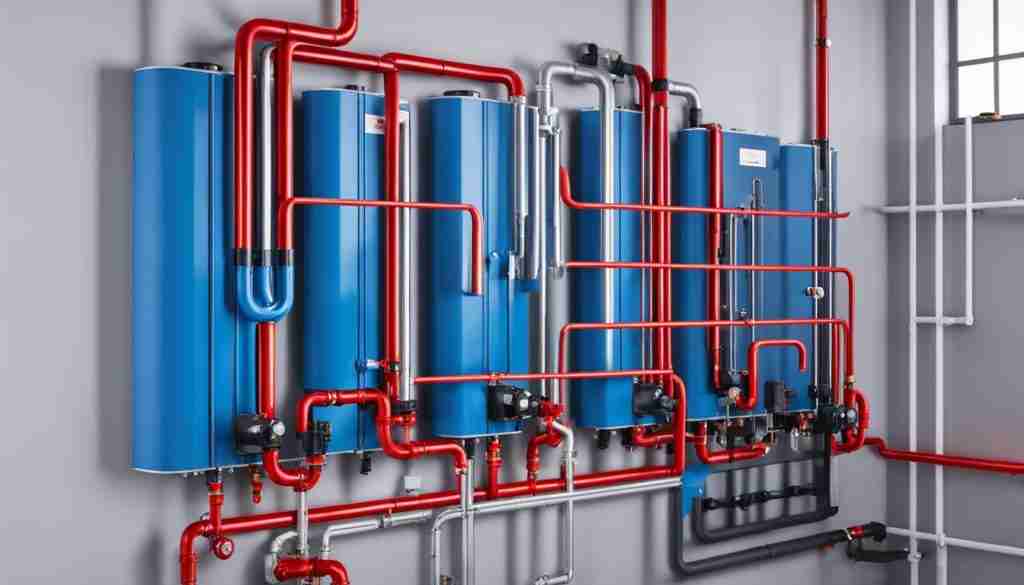
How Hydronic Systems Work
At the core of hydronic heating is the principle of heat transfer using water or an antifreeze solution. This liquid travels through a closed network of pipes, reaching radiators or underfloor heating loops that evenly distribute warmth. It’s a process that brings forth comfort without the noise and dust often associated with forced-air systems. The elegance of a hydronic setup lies in its simplicity and its capacity for seamless integration into renewable energy sources.
Bridging Hydronic Systems with Renewable Energy
When you pair hydronic systems with renewable energy, such as solar panels or geothermal pumps, you create a symbiosis of climate-friendly HVAC technologies. The liquid used in the hydronic system absorbs heat from these renewable sources, providing an eco-conscious path to temperature regulation in your home.
Employing Absorption and Biodiesel Technologies
As a homeowner or business owner, you’re always looking for ways to improve energy efficiency and reduce your carbon footprint. Among the suite of innovative solutions are absorption heating and cooling systems and biodiesel heating systems. These systems offer enticing energy-saving potential and are increasingly recognized as fundamental components of sustainable building management.
Absorption heating and cooling systems operate on a unique principle. They use a heat source, like solar thermal energy, geothermal energy, or even natural gas, to drive a thermodynamic cycle that does away with the need for compressors found in traditional HVAC systems. The result is a system that requires less electricity, operates more quietly, and delivers high efficiency in both residential and commercial settings.
Similarly, biodiesel heating systems are gaining traction in the push for greener living. Generated from renewable energy crops, biodiesel fuels can dramatically lower the volume of pollutants released compared to traditional oil-based heating. This move not only shifts towards a more sustainable energy supply but also supports farming communities engaged in the production of renewable energy sources.
Discover the latest advancements in renewable technologies within Sustainable Home Magazine, and how they can revolutionize your home’s efficiency and your approach to environmental stewardship.
Let’s delve into the specifications and benefits of these systems:
| System Type | Energy Source | Key Advantages | Environmental Impact |
|---|---|---|---|
| Absorption Heating and Cooling | Solar, Geothermal, Natural Gas | Reduced electricity use, Quiet operation | Lower greenhouse gas emissions |
| Biodiesel Heating | Renewable Energy Crops | Highly efficient, Cleaner burning | Less air pollutants, Supports sustainable agriculture |
Opting for energy-efficient HVAC systems doesn’t just lower your utility bills; it echoes a commitment to environmental responsibility. By choosing technologies like absorption and biodiesel, you’re taking proactive steps towards an eco-conscious future, all the while enjoying the comforts of modern heating and cooling.
As we continue to strive for a green revolution in home and commercial heating and cooling, the implementation of energy-efficient HVAC systems like those mentioned above is not just a trend; it’s an imperative. By exploring absorption and biodiesel options, you join the ranks of prudent property owners who are shaping the future of sustainable living.
Innovations in Sustainable HVAC Technologies
As a reader of Sustainable Home Magazine, you’re likely on the lookout for the latest advancements that pledge to transform the way we think about home climate control. Innovative sustainable HVAC technologies are at the forefront of this transformation, pushing the boundaries of what is possible in reducing our carbon footprint and enhancing energy efficiency.
Ice Air Conditioning: A Chilling Revolution
In the sphere of cooling technology, Ice Air Conditioning stands out as a novel method that delivers remarkable energy savings. This inventive system operates by freezing water in a tank overnight when energy demand is low. During the day, the ice is used to cool the air inside the building. It’s an approach that not only slashes energy consumption but also lessens the strain on the electricity grid during peak hours.
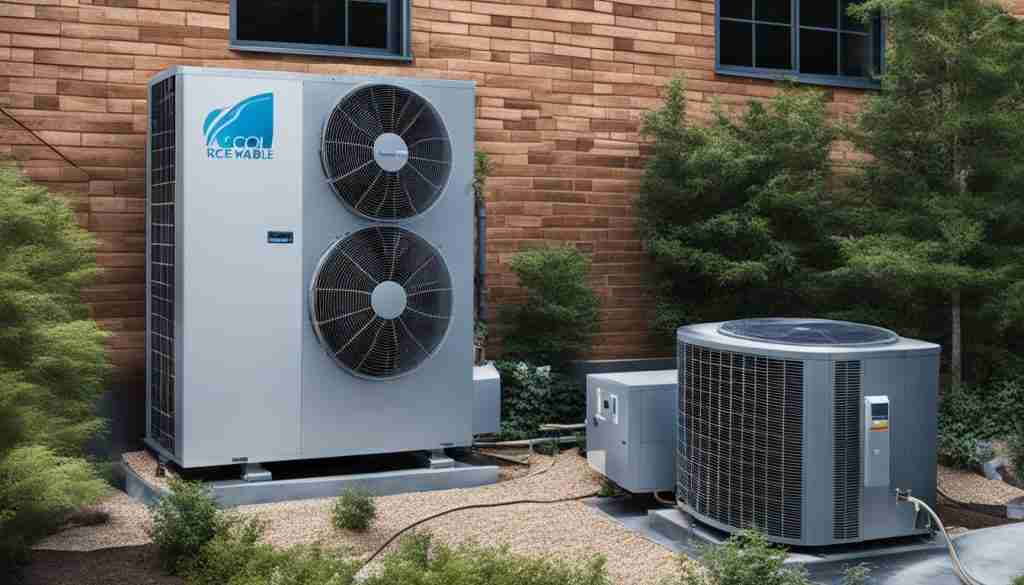
Advancements in Wind-Generated Heating
Turning our attention to heating, the development of Wind-Generated Heating systems exemplifies a significant leap forward. By harnessing the power of wind, these forward-thinking designs are capable of providing a clean, renewable method of heating water. Not only does this innovation carry the potential to significantly cut down on traditional energy use, but it also integrates seamlessly with existing wind technology infrastructure.
| Technology | Key Benefit | Energy Savings | Use of Renewable Energy |
|---|---|---|---|
| Ice Air Conditioning | Reduces peak power demand | ~30% | Works well with renewable energy sources |
| Wind-Generated Heating | Utilizes an abundant natural resource | Varies based on wind availability | 100% renewable when paired with wind energy |
Adopting solutions like Ice Air Conditioning and Wind-Generated Heating not only makes environmental sense but also aligns with the economic pursuit of lowering utility costs. With these innovative sustainable HVAC technologies, we can take one step closer to a greener, more resilient future.
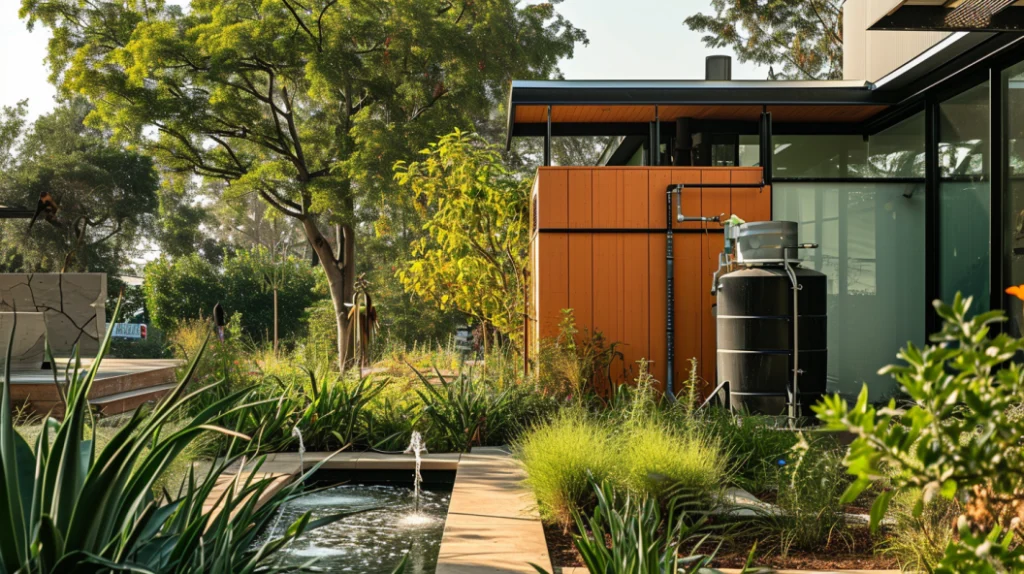
Deep Water Cooling: Eco-Friendly and Economical
As you explore sustainable HVAC solutions for your property, the innovative concept of Deep Water Cooling merits attention for its remarkable benefits. Groundbreaking in its approach, this system taps into the frigid depths of large water bodies, utilizing the naturally cold temperatures to efficiently cool buildings. One notable example is the application by Cadillac Fairview in Canada, which notably contributed to the company’s five-star GRESB rating, underscoring the system’s alignment with sustainability and economic efficiency.
Let’s delve into what makes Deep Water Cooling not just an environmentally sound choice but also a financially astute investment:
- Reduced Carbon Footprint: Deep Water Cooling boasts a significant reduction in electricity consumption, thereby curtailing the carbon emissions typically associated with traditional air conditioning systems.
- Operational Efficiency: By leveraging the unchanging cold temperatures of deep water, this cooling method operates with consistent efficacy, avoiding the fluctuations seen in air-based systems on hot days.
- Long-Term Cost Savings: The initial setup may come with a price, but the subsequent savings on electricity bills make Deep Water Cooling an economically viable choice over time.
Behold the cutting-edge deployment of Deep Water Cooling, with the following table illustrating its advantages in comparison to traditional cooling methods:
| Feature | Deep Water Cooling | Traditional AC |
|---|---|---|
| Energy Efficiency | Highly efficient, up to 90% | Varies, generally lower |
| Installation Costs | Higher initial investment | Lower initial costs |
| Maintenance Requirements | Lower due to fewer moving parts | Higher, requires regular servicing |
| Lifespan | Long-term, durable setup | Shorter, replacement often needed |
In the perpetual quest for sustainable living, adopting Deep Water Cooling systems represents a forward-thinking step that aligns closely with environmental stewardship and cost-effectiveness. The benefits showcased by companies like Cadillac Fairview serve as a testament to the promising future of this technology in shaping greener, more sustainable buildings.

Fighting Climate Change with Carbon-Neutral HVAC Solutions
As you delve into the world of Renewable energy HVAC solutions, it becomes evident that addressing our heating and cooling needs in a manner that maintains harmony with our environment is not just a trend—it is an imperative mission. Today, innovative carbon-neutral HVAC solutions are transforming the landscape, positioning themselves as powerful tools in the collective effort to mitigate climate impact. By leveraging technology that harnesses the earth’s renewable resources, such as geothermal and solar energy, we see a roadmap emerging toward a sustainable HVAC solution that aligns with the interests of both the planet and its inhabitants.
Introducing carbon-neutral technologies into the home is no longer a daunting task. But understanding the variety of options available is key to making informed decisions. The table below outlines a comparison between geothermal heat pumps and solar-powered HVAC systems—two front-runners in the hunt for sustainable and eco-friendly heating and cooling methods.
| Features | Geothermal Heat Pumps | Solar-Powered Systems |
|---|---|---|
| Energy Source | Earth’s stable underground temperature | Sun’s renewable energy |
| Efficiency | Can achieve up to 400% efficiency | Depends on solar irradiance and system design |
| Installation Costs | Higher initial cost, but eligible for tax credits and incentives | Varies, with many regions offering substantial incentives |
| Environmental Impact | Low CO2 emissions, reduces fossil fuel dependency | Minimal emissions, promotes clean energy use |
| Maintenance | Low maintenance due to fewer moving parts | Requires periodic maintenance to ensure peak performance |
| Longevity | Systems can last up to 25 years | Solar panels can last 20-25 years with inverters needing replacement at intervals |
In light of these details, you can see how pivotal it is to select a system that aligns with your values, location, and long-term sustainability goals. Each technology has its unique benefits and can serve as a cornerstone in the fight against climate change. As demand surges, these systems provide a reassuring promise of progress in our quest for a carbon-neutral future.
Whether you’re renovating an existing property or building anew, the move towards sustainable heating and cooling is a significant step in reducing our carbon footprint. If embraced on a larger scale, these renewable technologies can alleviate the stress on electrical grids and hasten our progression to a climate-resilient society.
As a reader of Sustainable Home Magazine, you are already part of a community that champions eco-friendly living. The transition to sustainable HVAC solutions is not only an ecological imperative but an opportunity to lead by example and invigorate others to take actionable steps towards a greener tomorrow.
Integrating Sustainable Systems into Modern Construction
As a reader of Sustainable Home Magazine, you’re likely familiar with the pressing issue of climate resilience in building design. Tailoring sustainable construction practices to include energy-efficient HVAC systems and green heating and cooling technologies is not just a trend—it’s a necessity for reducing carbon footprints and enhancing building efficiency for years to come.
Consider the transformative impact that eco-friendly HVAC options can have when implemented in the infancy of construction projects. By choosing geothermal or solar energy systems, architects and developers can infuse sustainability into the DNA of their structures, affording them a competitive advantage and aligning with global environmental standards.
Planning for a sustainable future entails incorporating innovative green systems early in the construction phase, ensuring every built environment contributes to a cleaner, healthier world.
Now, let’s delve into the comparative advantages of various sustainable HVAC technologies available for modern construction:
| Technology | Benefits | Cost-Efficiency |
|---|---|---|
| Geothermal Heat Pumps | Use consistent underground temperatures for heating and cooling, reducing reliance on fossil fuels | High initial cost, but long-term savings through reduced energy bills |
| Solar Energy Systems | Harness the sun’s power for electricity and heating, leading to decreased greenhouse gas emissions | Costs mitigated by tax credits; significant long-term utility savings |
| Biomass Systems | Utilize renewable plant-based materials, offering a carbon-neutral alternative to conventional heating | Competitive fuel costs and potential government subsidies |
- Geothermal systems capitalize on thermal inertia, the earth’s natural buffer against temperature fluctuations.
- Solar power, an inexhaustible resource, presents an ever-improving technology with expanding applications for residential and commercial buildings.
- Biomass heating options are gaining traction as a viable and sustainable heat source, particularly in regions with abundant organic matter.
By prioritizing these systems during the architectural phase, buildings can become formidable allies in the fight against climate change. They not only stand the test of time but also raise the bar for sustainable construction benchmarks.
Remember, the choices made in today’s construction industry will resonate for decades, influencing energy consumption patterns and environmental impact. By embracing sustainable HVAC solutions, you can ensure that your construction projects remain at the forefront of ecological innovation and efficiency.

Smart Control: Enhancing HVAC Efficiency with Automation
In the realm of energy-efficient home climate management, the rise of Smart Control HVAC systems has been nothing short of revolutionary. These systems represent the intersection of convenience and sustainability, providing you with the tools to actively decrease your energy consumption without sacrificing comfort. Automation in HVAC systems is not just a trendy feature—it’s a functional advancement that aligns with the pressing need for more environmentally responsible energy usage in our daily lives.
How Smart Thermostats Contribute to Energy Savings
Smart Thermostats have transformed the way we interact with our home environments. By learning your schedule and preferences, these devices ensure your HVAC system operates optimally—only when necessary. The real beauty lies in their ability to make real-time adjustments based on external weather conditions and internal temperature targets. This means you’re not just saving energy; you’re using it intelligently, which translates to considerable savings on utilities and a significant reduction in your carbon footprint.
User-Friendly Interfaces and Monitoring
The technological sophistication of HVAC automation is matched by its User-Friendly Interfaces. You don’t need to be tech-savvy to take full advantage of these systems. With an intuitive design, monitoring your home’s heating and cooling has never been easier. Such interfaces allow you to track energy usage patterns, receive maintenance alerts, and customize settings from anywhere, at any time. This seamless integration of user-friendliness and smart technology empowers you to be a more conscientious consumer of energy, fostering a more sustainable and economically savvy lifestyle.
FAQ
What are Sustainable Heating and Cooling Systems?
Sustainable heating and cooling systems are eco-friendly HVAC solutions designed to provide temperature regulation within buildings while minimizing environmental impact. They use renewable energy sources and energy-efficient technologies to heat and cool spaces, thereby reducing greenhouse gas emissions and reliance on fossil fuels.
How Do Geothermal Heat Pumps Work?
Geothermal heat pumps harness the consistent temperatures beneath the Earth’s surface by circulating a liquid through underground pipes. This system absorbs heat from the ground in the winter to warm buildings and disperses heat back into the ground in the summer to cool them. This exchange is facilitated by a heat pump, which delivers efficient heating and cooling throughout the year.
Can I Decrease My Energy Bills by Using Renewable Energy HVAC Solutions?
Yes, adopting renewable energy HVAC solutions such as geothermal systems, solar heating and cooling, and biomass systems can significantly reduce your energy bills. These solutions often have higher efficiencies and utilize renewable resources, which have lower operating costs than traditional energy sources.
What are Passive Solar Design Principles?
Passive solar design principles involve the strategic use of a building’s architecture to maximize heat absorption from the sun during the winter and minimize heat gain during the summer. Features such as large south-facing windows, thermal mass materials that store heat, and shading devices are commonly used to achieve natural temperature regulation.
What Incentives are Available for Installing Geothermal Systems?
Homeowners and businesses installing geothermal systems may be eligible for various incentives, including the Federal Renewable Energy Tax Credit which offers a percentage of the installation cost as a tax credit. Additionally, many states provide their own incentives, rebates, and grants to reduce the initial financial barrier to adopting these energy-efficient systems.
How Are Hydronic Heating Systems Integrated with Renewable Energy?
Hydronic heating systems can be integrated with renewable energy sources by using solar collectors or geothermal heat pumps to heat the liquid, typically water or an antifreeze solution, that is circulated through the system. These sources provide a sustainable way to generate the necessary thermal energy for the hydronic system to heat a property.
What is Deep Water Cooling and How Does It Benefit the Environment?
Deep Water Cooling is a system that uses the cold temperatures from deep bodies of water to cool buildings. It significantly reduces electricity consumption and peak power demand, which translates to lower greenhouse gas emissions from power plants, making it an eco-friendly alternative to traditional air conditioning systems.
What Makes HVAC Systems Carbon Neutral?
HVAC systems are considered carbon neutral when they utilize energy sources that do not contribute additional carbon dioxide to the atmosphere. This includes systems powered by solar, wind, geothermal, or biomass energy. These systems replace the need for fossil fuels, which are the primary source of carbon emissions in traditional HVAC systems.
How Do Smart Thermostats Contribute to Energy Savings?
Smart thermostats contribute to energy savings by allowing users to precisely control their heating and cooling systems. They can learn a homeowner’s behavior, adjust to real-time conditions, and be controlled remotely, which all lead to more efficient energy use, lower utility bills, and reduced environmental impact.
Are Sustainable HVAC Systems Cost-Effective in the Long Run?
Despite the higher upfront cost of some sustainable HVAC systems, they are often more cost-effective in the long run. The reduced operating costs, longer lifespans, lower maintenance requirements, and various financial incentives available make these systems a financially viable option in addition to their environmental benefits.

